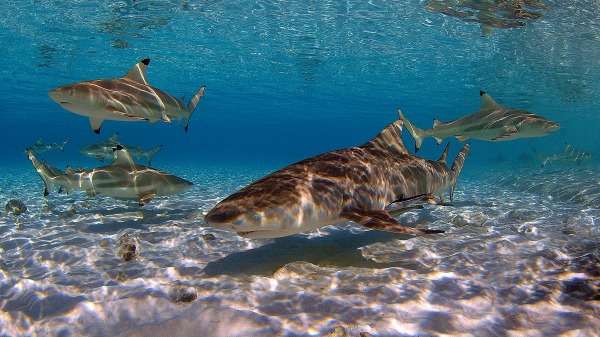A lemon shark and a blacktip reef shark. Credit: Peter Verhoog/Dutch Shark Society
Reef sharks at Ningaloo are largely home bodies but female blacktip reef sharks (Carcharhinus melanopterus), might be swimming long distances to give birth in food-rich waters, research suggests.
Marine biologists tagged 83 reef sharks near sanctuary zones at Coral Bay and Mangrove Bay and tracked their movements to assess how much protection the marine park affords the sharks.
They examined the movements of blacktip reef sharks, grey reef sharks (Carcharhinus amblyrhynchos) and sicklefin lemon sharks (Negaprion acutidens) at Ningaloo Reef over two years.
Australian Institute of Marine Science experimental scientist Conrad Speed says reef sharks are essentially "home bodies", with most sticking to a fairly small area ranging from less than a square kilometre to more than 20km2.
But, they determined some female blacktip reef sharks made long migrations in the summer months, including one who swam 275km.
"We had five female adult blacktips that we tagged initially in Coral Bay that swam between Coral Bay and Mangrove Bay," Dr Speed says.
"Each way it's about 130-odd kilometres, so it's quite a long distance for a shark that's only a metre and a half in length.
"The sharks were swimming quite quickly, there's obviously a purpose behind these really long distance movements.
"What we think's happening is that the blacktips are likely moving from Coral Bay all the way to Mangrove Bay to give birth."
Juvenile sharks stick to mangroves and lagoon
Dr Speed, who conducted the study as part of his PhD at Charles Darwin University, says mangroves serve as a good nursery area for young sharks.
"In our study [the juveniles] primarily stayed in the mangrove habitat and in the lagoon area, and that's because they don't need to range further to find more food," he says.
"Mangrove areas are very rich in food that's suitable for small sharks and they're offered a fair amount of protection in mangroves from larger animals."
Adult sharks range further because they use different habitats to juveniles and need to find more food, Dr Speed says.
"They also either need to find a mate or find an area that's suitable to give birth," he says.
The sharks were tagged with acoustic transmitters that could be picked up by a series of underwater acoustic receivers deployed along the reef.
The receivers are similar to the set up used by the Fisheries Department to detect sharks off the coast of Perth and the South West.
More information: "Reef shark movements relative to a coastal marine protected area," Regional Studies in Marine Science, Available online 12 May 2015, ISSN 2352-4855, dx.doi.org/10.1016/j.rsma.2015.05.002
Provided by Science Network WA






















